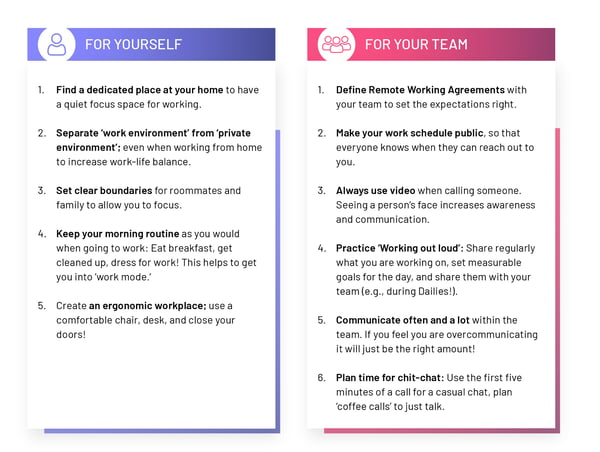The recent Coronavirus outbreak has shaken things up and has also given us a fresh perspective on life and situations. We had to quickly adapt to the changing circumstances and switch to an alternative form of working: remote working, or popularly known as working from home (WFH).
Even for those who are used to working from home, it is a sudden shift in work-life, because suddenly, everything is going to be done without in-person contact. I think many of us understand that working from home is not simply continuing business as usual but also has some challenges baked in.
One of the biggest concerns that many people share is the fear of a sudden loss of productivity. This is something I can totally relate to. You lose all face-to-face interaction that kept your business running. So, living up to our idea of ‘making distance irrelevant’, here are some tips and tricks for staying productive at personal, team and organizational levels, when suddenly going remote!
For yourself
Working from home is quite a challenge when it comes to keeping private and professional lives separate. A lack of these boundaries can easily disrupt your focus and may even blur the lines of private time and work time. Such blurring is ill-advised. When you are too focused on work in your spare time, you’ll easily get overwhelmed and similarly, being over-focused on personal matters while working will hamper your productivity.
Here are some simple tips for you to maintain a healthy work-life balance:
1. Find a dedicated workplace at home
Having a quiet and dedicated ‘focus space’ brings a two-fold benefit. Firstly, you get a clear space to work and focus. Secondly, you have a dedicated, physical place related to your job. Having a dedicated place, like a separate room with all your work stuff in it, makes it psychologically easier to switch from ‘work mode’ to ‘private mode.’ After some time, when you enter the room, you’ll notice that it is like going to the office, and when leaving, it is like traveling home!
2. Set clear boundaries
Setting boundaries is a crucial factor when working from home. This is especially true in times when your roommates or family members are also working remotely. Sit with your family, roommates, and significant others to agree on a set of rules that apply while you are working from home. Find a clear agreement on when it is okay to enter your work room, or how to deal with lunch times and breaks. For example, a simple rule can be to hang a ‘Do Not Disturb’ flag on the door’s handle. When it is placed there, no one can enter, because you need focus and space at that time. When it is removed, it means anyone can come in. I implement it similarly at home. When the door to my work room is closed, it means I am 'not available' and ‘in the office' at that time. When it is open, it means my kids and wife can enter. Setting such ground rules establishes the right expectations from each other and forms the basis for maintaining good relations at home too!
3. Keep a morning routine
I know it is way too easy to drop out of the usual ‘going to work routine’ and slide out of bed, right to your desk, in order to start the day. My advice: Stick to a clear routine to get the day started. Act as if you would go to work: Get breakfast, clean up, dress for work, and then move into your ‘office room’ to start the day. This helps in establishing good morale with people at home and also prepares you mentally for the work ahead. It is one of the most important things that helps me focus for the day. Besides, you too wouldn’t want anyone to see you in pyjamas on a video call 😉
4. Create an ergonomic workplace
When working from home, it is tempting to sit on the couch, plonk the laptop on your knees, and start typing. As comfortable as it might feel in the beginning, you (or your physio) will soon recommend that it isn’t that comfy in the long run. Our office desks and furniture are ergonomically designed. Our homes usually aren’t. Thus, it is very important that you make your ‘home office’ as ergonomically useable as possible. Use a good quality desk, adapt it to your optimal height, position your screen with matching lighting, and use a chair that does not cause back pain. In essence, the ergonomic guidelines that are in place at work should apply when working from home too.
For your team
Once you’re set up (psychologically and physically comfortable) to work from home, it is time to focus on interacting as a team. The biggest impediment for remote teams is the distance in communication. When we are all co-located in the same office (or building), it is much easier to simply get up and talk to each other. Now that we are remote, you’ll notice we lack that flexibility and ease in communication. Here are some things you can consider in enabling great team interactions:
1. Define remote working agreements
When communicating virtually, it is important to be clear about how we communicate as a team. Having such clarity and making it transparent to everyone helps in overcoming many challenges in remote collaboration. Try to address these important questions: What do I need to share with others? Which communication channels to use for which purpose? And, especially in teams spread across time zones: Which time zones do we use for coordination? Make sure that you and your team arrive at a clear consensus on answers to all such questions. To make that easier, I came up with a Remote Agreement Canvas that collects all this information on one page. On the one hand, the Remote Agreement Canvas can guide in agreement drafting, and on the other, it makes it easily shareable.
2. Keep a public work schedule
Being physically separated from your colleagues makes it difficult to know about their availability and schedule. When in office, you can just walk over and check whether they have time for a quick chat. Things change when all are working remotely. What clearly helps here is to make your work schedule and meeting calendars public. Or at least visible to your colleagues. It should be easy for them to see if you’re currently in a call or require some focus time or if you’re free for a quick chat. Making your work schedule public also adds to the trust factor. Knowing what your co-workers are doing, by being able to see which calls they are in, prevents any estrangement or personal disconnect. So set your calendars to a mode where your team members can stay current with your schedule at any given time.
3. Work out loud
Many good practices of working in a remote team are about staying connected and knowing what’s going on within the team. Working out loud is another practice for that. Basically, it is about telling everyone what you are working on, what you intend to start, and what you have just completed. For example, you can use a common team chat (like Microsoft Teams or Slack), to share updates about your work. If you take this with a ‘reporting’ vibe, you’re misunderstanding the point. It is less about accountability and more about communication. Working out loud also helps to prevent any potential distrust because you actively show how you are contributing to team success instead of slacking off.
4. Communicate often and a lot; in fact, overcommunicate!
As said before: Success in distributed and remote working goes hand-in-hand with lots of communication. The greatest trap in remote working lies in communicating lesser than before. It becomes very easy and likely that one distances oneself and just works in isolation, which may lead to a disconnect in the team. It may feel weird in the beginning but you must communicate a lot more than you would when co-located. Just post your current thoughts in a team chat, or even call people throughout the day, when there’s something you’d like to share. In fact, in my experience, when you have the feeling that you are overcommunicating, it is often the right amount for others.
5. Plan some time for chit-chat
The last tip also plays into the communicate—communicate—communicate aspect—just that, here it includes talking about things that are NOT related to work. I’ve seen a lot of teams going remote and only focusing on work-related communication. The result is that you quickly disconnect on a personal level. A great team is not only connected through work but also by social ties between the team members—by good inter-personal chemistry. To keep these ties strong, it is imperative to also chit-chat with each other regularly. You should ensure it isn’t missed out while working remotely. It can be very simple, like dedicating the first five to ten minutes of each meeting for small talk and ice-breakers among colleagues.
Another great method we used successfully was in planning video calls for informal coffee breaks. Just setting aside 30-60 minutes a day for everyone to get a cup of coffee (or tea) and dialing into a video call has a huge impact on team morale and dynamics. It’s this informal exchange that generates good rapport, great ideas, and top-notch productivity.
Conclusion
Let’s wrap this up: Effective remote teams require a strong foundation around two things: psychological preparation on an individual level and lots of communication between co-workers. Creating a ‘focus space’ and setting boundaries helps you in focusing during home office hours and in achieving work-life balance. On the other hand, constant communication and sharing as much as possible, allows a team to stay connected, focused, and effective when everyone is physically disconnected. To sum everything in one sentence, I’d say: In order to be a powerful team, you need to be socially close, when being physically distant.
Here are all the tips and tricks for working remote effectively, summarized for a quick glance:

This post is only the first in a series of posts on effective remote working.
Stay tuned for my upcoming posts in this series:




